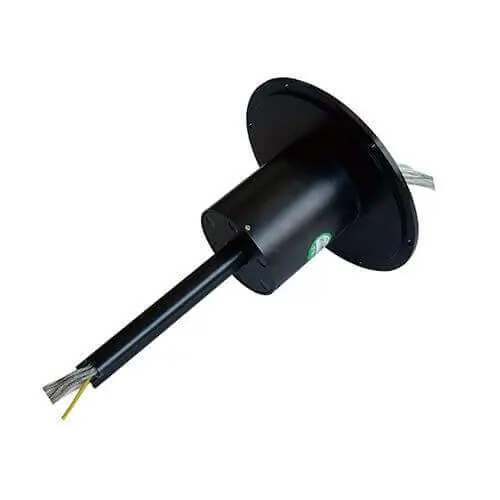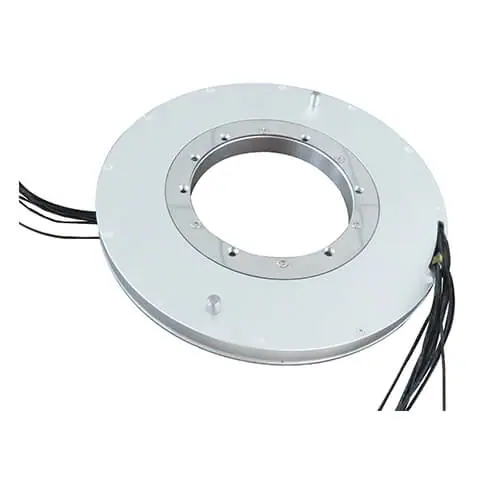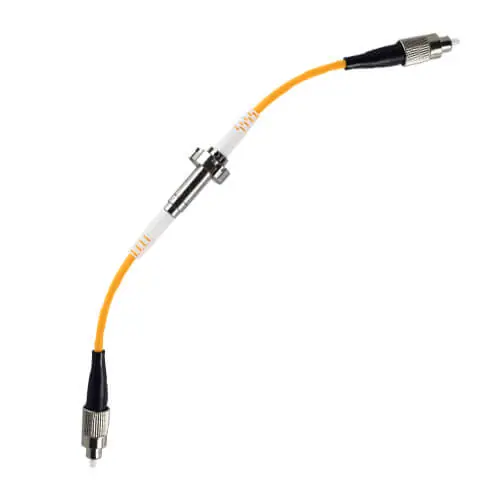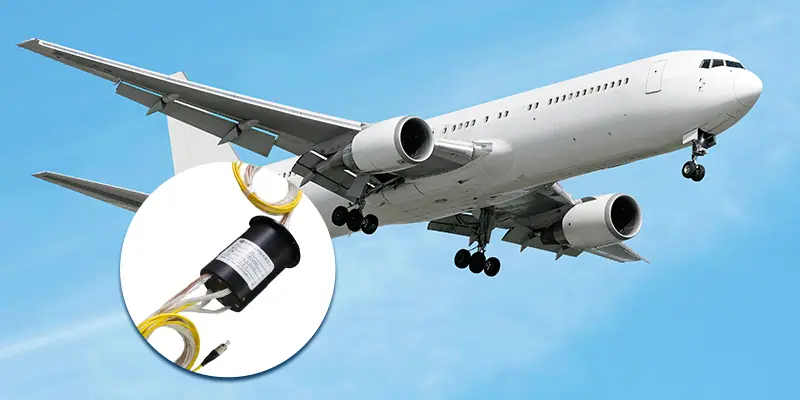In today’s technologically-driven world, seemingly inconspicuous components often prove to be indispensable, with one such example being wire slip rings. Enabling the transfer of power and data between stationary and rotating components in various systems, these electromechanical devices have earned their place as crucial elements in a wide range of applications. By means of their unique configuration and design, wire slip rings establish a constant and reliable connection, eliminating the drawbacks found in machines with dynamic parts and ensuring seamless operation.
Though somewhat unassuming, the function and significance of wire slip rings extend across numerous industries, including medical, aerospace, and renewable energy. Within the medical sector, slip rings are vital in powering sophisticated equipment such as CT scanners and MRI machines. They not only maintain an unwavering supply of power to the rotating gantry but also transfer crucial patient data to stationary computer systems. In the challenging environments of aerospace operations, wire slip rings withstand harsh conditions to ensure proper data transmission and control in satellite systems, radar equipment, and unmanned aerial vehicles. Additionally, renewable energy solutions, such as wind turbines, rely on slip rings for effectively conveying electrical power from the spinning turbines to the stationary electrical grid, thereby forming an essential link in green energy production.
The omnipresent nature of wire slip rings across these diverse industries elucidates their invaluable role in maintaining the efficient functioning of contemporary technology.
The Working Principle of Wire Slip Rings
A wire slip ring, simply put, serves as a critical bridge between stationary and moving parts of machinery. This bridge allows the exchange of power or data signals while maintaining a constant connection. The significance of this unassuming device’s role lies in its capacity to overcome challenges inherent in dynamic mechanical systems, ensuring uninterrupted energy supply and data transfer, even while parts of the machinery remain in continuous motion.
Delving into the makeup of a wire slip ring, one would observe a combination of various components working together in a carefully orchestrated interaction. At the heart of this device is the rotating ring, also known as the rotor, which is mounted on a rotating shaft. This rotor, typically manufactured from highly conductive material like copper, spins with the rotating component of the machinery. Besides the rotor, another pivotal part of the slip ring is the stationary brush or stator. This brush, often made from precious or semi-precious metals for their excellent conductive properties, interacts directly with the rotor, but it is confined to rotational motion.
Despite their individual state of movement or rest, the rotor and brush crucially stay in constant contact, which forms the backbone of a wire slip ring’s function. The transfer of electrical power or signals happens through this point of contact. As the rotor rotates in tandem with the machinery, the stator, through the wires connected to it, picks up the electrical signals or power from the rotor and channels it to the fixed component of the machinery.
The beauty of this process lies in its continuous nature, where data and power can be transmitted unceasingly without losing connection, defying the limitation of rotational parts. This is the principle on which wire slip rings operate, making them unarguably integral in various fields of technology.
Types of Wire Slip Rings
While wire slip rings share a common purpose of ensuring continual electrical connection within dynamic systems, there exists an array of types, each tailored to meet unique demands and applications.
Capsule Slip Rings

These are notable for their compact and cylindrical design, ideal for overcoming space constraints in machinery. Encapsulated within a sealed housing, these slip rings protect the electrical circuits from environmental factors, thereby enhancing their longevity and reducing maintenance needs. They are apt for applications involving low to medium circuits.
Through-Bore Slip Rings

As their name suggests, these slip rings feature a central hole – or bore – that allows for mounting around long shafts or cables. They offer a great deal of flexibility in incorporating varied wires and conducting multiple currents. Their design is perfect for systems that call for the passage of pneumatic or hydraulic lines through the center.
Pancake Slip Rings

These slip rings are characterized by their flat, disc-shaped design, which facilitates high-speed rotations. They adopt a concentric ring arrangement, which places several electrical tracks on a single horizontal plane. They are suitable for applications that require high-speed and smooth rotation with low-mechanical noise.
Mercury Slip Rings
Often referre d to as ‘mercury wetted slip rings,’ they are unique in their use of mercury as a conductive medium rather than conventional solid brushes. They offer low electrical noise, minimal contact resistance, and longevity since there’s no wear and tear from mechanical brushes. However, due to the use of a toxic substance like mercury, they are typically used in very niche applications where these benefits outweigh the environmental and handling concerns.
d to as ‘mercury wetted slip rings,’ they are unique in their use of mercury as a conductive medium rather than conventional solid brushes. They offer low electrical noise, minimal contact resistance, and longevity since there’s no wear and tear from mechanical brushes. However, due to the use of a toxic substance like mercury, they are typically used in very niche applications where these benefits outweigh the environmental and handling concerns.
Fiber Optic Slip Rings (FORJ)

Fiber optic slip rings, or FORJ (Fiber Optic Rotary Joints), are a type of slip ring specifically designed for transmitting optical signals. These slip rings are vital for high-speed data and high-definition video transmission over long distances. They withstand interference better than traditional slip rings and are ideal for applications involving telecommunications, radar, and other high-bandwidth operations.
Each type of slip ring comes with its set of features and advantages, and their selection depends greatly upon the specific requirements and spatial constraints of the machinery they are installed in. Matching the correct type of slip ring to its application is essential to ensuring the optimum performance and longevity of the device.
Key Considerations for Choosing the Right Wire Slip Rings
Selecting the most appropriate wire slip ring for any project necessitates a diligent evaluation of several key variables. Each slip ring application has its own unique challenges, and therefore, there isn’t a one-size-fits-all solution. Here are some pivotal factors to consider:
Application-Specific Requirements: Your specific application will largely determine the type and configuration of the wire slip ring needed. For instance, the number of circuits a slip ring contains needs to match your equipment’s requirements for power, signals, and data transmission. The speed of rotation is another integral factor, with some slip rings designed for high-speed rotations while others are better suited for slower speeds. Furthermore, the current rating or the maximum current that would need to pass through the slip ring should align with the demands of the application, ensuring the safe and efficient operation of the device.
Environmental Factors: The conditions in which a slip ring operates can greatly affect its performance and lifespan. Factors like temperature, humidity, and the presence of dust need to be considered while selecting a slip ring. High temperatures might demand a slip ring with superior heat dissipation properties, while operations in high humidity or dust might require a sealed or encapsulated slip ring design to protect the internal components from environmental damage.
Size Constraints and Mounting Options: Size constraints imply the physical space available for the slip ring in the machinery. Some machinery may require compact slip rings, like capsule slip rings, while others with more room could accommodate larger, through-bore slip rings. Similarly, mounting options such as flange mounting, wall mounting, or free-standing installation need to be considered based on the design of your machinery.
Reliability, Longevity, and Maintainability: The ideal slip ring should be of high quality, reliable, and with long-lasting performance. Additionally, consider the maintenance requirements. A slip ring with minimal maintenance can lead to less downtime, thereby ensuring seamless operation.
Cost and Budget: When making a cost-effective decision, it’s important to consider factors beyond just the initial price. For instance, the 6-wire slip ring price should be balanced against its durability, maintenance requirements, and how well it aligns with your specific needs. A 6-wire slip ring that appears more expensive upfront but offers exceptional performance and durability may ultimately prove to be more cost-effective in the long run. By assessing both short-term and long-term value, you can make a more informed decision that suits your budget and requirements.
Together, these considerations play a crucial role in guiding the selection of the right slip ring for your application, ensuring a higher return on your investment and a better functioning of your machinery.
Applications of Wire Slip Rings
Wire slip rings are ubiquitous in their application across a multitude of industries. Their primary role of abating interrupted power and data transmission in rotating machinery makes them invaluable in both developing and well-established realms of technology.
Medical Industry: In the realm of healthcare, wire slip rings play a crucial role in the operation of sophisticated imaging technologies like Magnetic Resonance Imaging (MRI) and Computed Tomography (CT) scanners. In these devices, the slip rings deliver power to the rotating gantry simultaneously as they transmit patient data from the moving parts to the stationary computational systems.

Aerospace and Defense: Wire slip rings can weather harsh conditions, making them excellent for aerospace applications. They aid in running satellite systems by transmitting control data between stationary ground systems and rotating satellite mechanisms. Additionally, they ensure proper data transmission in radar systems and unmanned aerial vehicles (drones), where maintaining a constant connection is critical for operational success.

Renewable Energy: In renewable energy technology, especially in wind turbines, slip rings form a vital link in energy production. They transfer electrical power generated from the rotating wind turbines to the stationary electrical grid, making the generation of green energy effective and reliable.

Industrial Automation: In the complex world of industrial automation systems, slip rings ensure smooth operation in robotic arms and rotary tables where continuous rotation and transmission of power and signals are required. They help maintain the much-needed connectivity in these versatile machinery, giving us the automated world we live in.
Communication: High-frequency and fiber optic slip rings are commonly used in broadcasting and telecommunications. They ensure seamless transfer of high-speed data and high-definition video signals, meeting the demands of modern communication technology.
Maritime Operations: In maritime operations, slip rings are applied in dynamic positioning systems, propeller systems, and radar antennas on ships where they convey signals and supply power, ensuring optimal ship functionality and navigation.
These diversified applications illuminate the vital role of wire slip rings in modern industry and technological advancements. Given their manifold applications, the value and potential of these electromechanical devices are truly impressive. Their consistent functionality in many different arenas testifies to their adaptability and the pivotal role they play in much of the machinery that powers our world.
The Future of Wire Slip Rings
As pragmatic as they are in their current state, the future of wire slip rings is anything but static. This forward-thinking field continually evolves to maintain pace with technological advancements and meet ever-changing demands.
Emerging Trends and Technological Advancements: The world of wire slip rings is mirroring the technological advancements of the industries it serves. Key trends involve the enhancement of materials used in slip ring production to ensure better wear-resistance, improved data transmission quality, and minimized electrical noise. The exploration of novel contact materials and designs promises to elevate operational longevity and reliance on maintenance. The move towards miniaturization also continues, with demands for ultra-compact slip rings, especially in medical and space applications.
Advances in encapsulation and sealing technologies are improving the environmental resilience of wire slip rings, thereby expanding their applicability in harsher conditions. There is also a trending focus on ‘smart’ slip rings equipped with sensors and diagnostic capabilities, embracing the larger wave of IoT (Internet of Things) and Industry 4.0.
The Impact of Wireless Power and Data Transmission: The advent of wireless technologies rattles the future of any wired connections, and wire slip rings are no exception. Wireless power and data transmission offer a tempting path towards more flexible and maintenance-free solutions, especially in applications with strict size constraints or those demanding minimal contact.
Yet, wire slip rings possess some inherent advantages that make them indispensable. They offer robust and reliable connections, capable of handling greater power loads and diverse signal types simultaneously—an aspect that still challenges wire-free alternatives. Moreover, slip rings can operate over extended periods with minimal disruptions, a scope that wireless technologies continue to strife with due to their sensitivity to environmental factors.
Therefore, while it is reasonable to anticipate an intertwined existence of wire-based and wireless solutions, wire slip rings can, and likely will play a vital role for the foreseeable future, continually adapting to serve new needs and possibilities.
In conclusion, the future of wire slip rings remains dynamic and responsive, holding the promise of many exciting developments. Nevertheless, it’s necessary to remember that the best slip ring solution will always be context-dependent, shaped by a balance of technological feasibility, practical demands, and cost-effectiveness.
Conclusion
From their unassuming role in machinery to their critical function in powering innovations, wire slip rings represent an integral part of modern technology. By staying updated about their advancements, we can enhance user experiences, align with future requirements, and optimize the potential of rotating systems. In the world of rotary connections, wire slip rings truly are the points that keep us turning.
FAQs about Wire Slip Ring
Wire slip rings, with their wide variety of applications and types, often give rise to several questions and concerns. This FAQ section is designed to address a few common queries and provide a clearer understanding of wire slip rings.
Q1: Can wire slip rings be used for both power and data transmission?
A: Yes, wire slip rings can be used for both power and data transmission. While some slip rings are designed primarily for power transmission, others are engineered for transmitting data signals or a combination of both. The essential part of ensuring efficient operation is to choose a slip ring that is tailored to meet the specific requirements of your application. This may include considering factors such as the number of circuits, current rating, and speed of rotation.
Q2: What is the life expectancy of a wire slip ring?
A: The life expectancy of a wire slip ring primarily depends on its design, materials used and operating conditions. Generally, slip rings with solid brushes have a finite lifespan owing to the friction between brushes and rings. Advanced slip rings, like mercury wetted slip rings, have a more extended life expectancy due to the absence of mechanical brushes, but they are limited by the use of mercury in their conductive medium, which raises environmental concerns.
The operating conditions, including environmental factors like temperature, humidity, dust, and the application’s speed and load also affect the slip ring’s life. To prolong the life of your slip ring, it’s essential to choose one that is appropriate for your specific application and may require periodic maintenance.
Q3: What are the typical data rates that wire slip rings can handle?
A: Data rates for wire slip rings vary depending on the design and materials used. For instance, fiber optic slip rings (FORJ) can handle very high data rates, up to 10 Gbps or more, making them ideal for high-speed data and high-definition video transmission in telecommunications and other high-bandwidth operations. Electrical slip rings, on the other hand, offer lower data rates, typically ranging from a few kbps to several Mbps.
As with other aspects of slip ring selection, it’s crucial to identify a slip ring that matches the specific data transmission requirements of your application.
Q4: Can slip rings handle different types of signals simultaneously?
A: Yes, slip rings can handle different types of signals simultaneously. They can be custom-engineered to accommodate various circuits for power, data, and other signals like RF (Radio Frequency) or video signals, all in one device. However, the performance and functionality of such slip rings depend on factors such as shielding, separation, and the proper selection of contact materials to minimize interference and preserve signal integrity.
Q5: Do wire slip rings transmit data?
A: Yes, wire slip rings can transmit different types of signals, including data.
Q6: How long will a wire slip ring last?
A: Under recommended conditions, quality wire slip rings are known to perform reliably for millions of rotations.
Q7: What’s the role of wire slip rings in renewable energy?
A: In wind turbines, wire slip rings transfer power and signals from the rotating turbine to the stationary grid, making them essential to renewable energy production.
See What We Can Do


